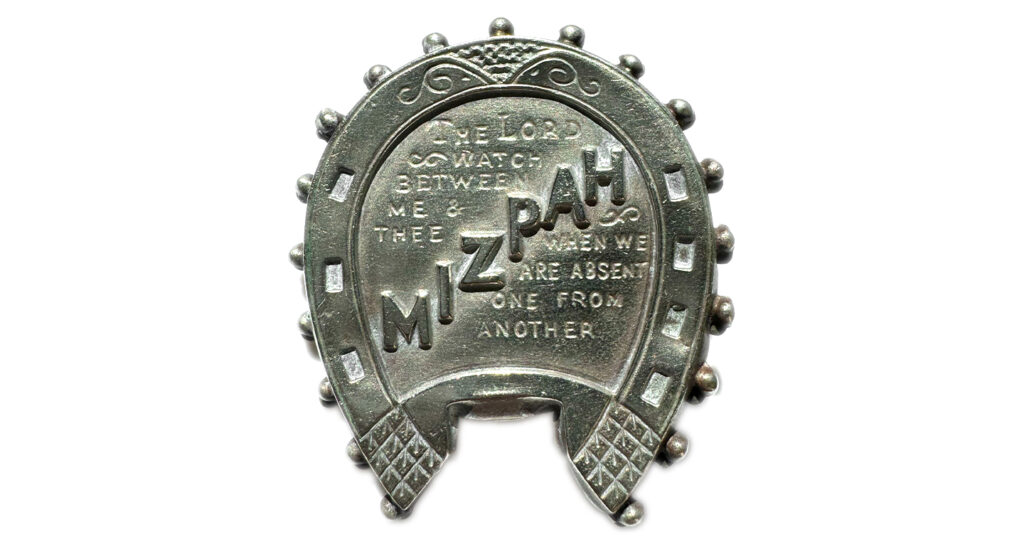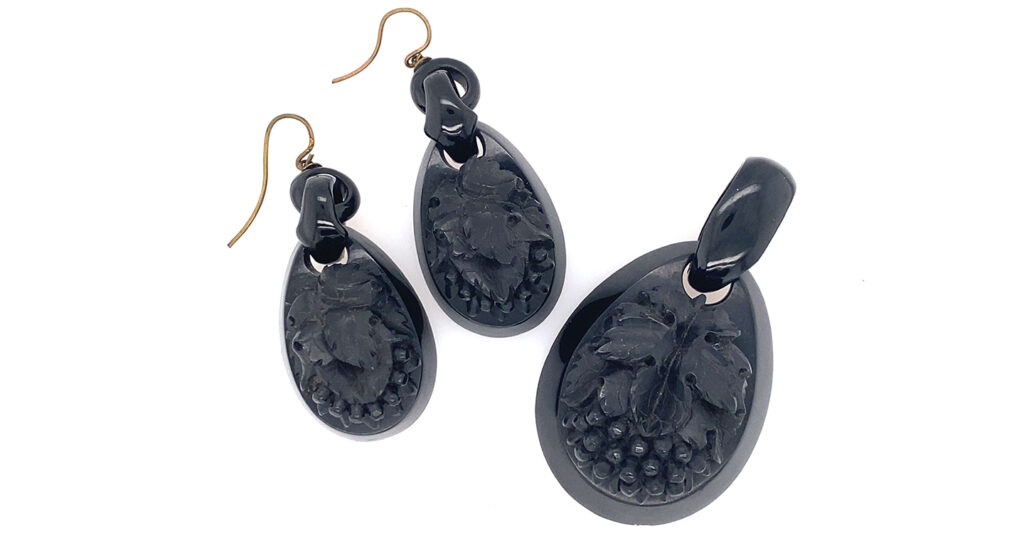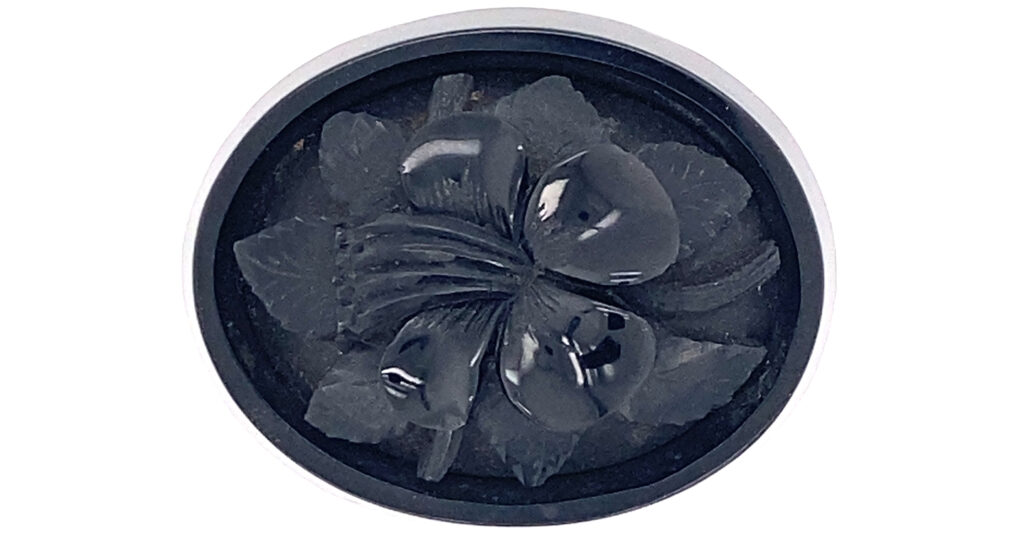Rose Symbolism in Jewels

The Museum of Whitby Jet is a genuine establishment of living history. Combined with the store W. Hamond, it presents the oldest connection to 19th century Whitby Jet manufacture that still exists. It is a tribute to the 1500 men and 200 shops that existed in 1873 to produce the finest quality of Jet available in the world. Their craft, of carving, turning and polishing jet held a standard that set the British Empire beyond any other jet industry in the world, being held in the highest regard by Queen Victoria herself.
Due to the popularity of Whitby Jet, the instances of its carving designs are almost infinite. The Victorians relished the romantic and sentimental language of flowers. They were educated, had access to new wealth and were the first affluent middle class that could afford leisure time. Travel was a part of seasonal Victorian lifestyle and cottage industries emerged with the connection of rail lines that ferried these sentimental people across Britain. Whitby’s popularity as the centre of Jet fed its local community and its economy. Carvers were charged with appealing to the most popular designs from the visitors, who requested sentimental tokens to gift to their loved ones.
This Art of Mourning series is in partnership with the Museum of Whitby Jet and is a look at the jewels of the museum through the eyes of the Victorians who requested and understood the love language of flowers.
To achieve this, part 1 of the series is an introduction to Whitby Jet, which can be read below:
Link > Discover Whitby Jet
Part 2 is an understanding of ‘floriography’, a late 18th and 19th century attempt by philosophers and writers to connect floral discoveries of the world to emotion to empirical fact. This can be read below:
Link > Understanding Symbolism: Botany and Floriography
Symbolism of The Rose

William Shakespeare’ wrote “a rose by any other name would smell as sweet” in Romeo and Juliet and its interpretation throughout history holds many other names for its symbolic meaning. Giving a rose is a statement of a person’s beauty and the unfailing love and hope between them. While this is almost a universal standard of the rose’s meaning, a cabbage rose is considered to be an ‘ambassador of love’, while a white rose represents ‘I am worthy of you’.
The red rose has many different meanings in its history. The red rose is the most popular colour given and has several meanings. The red colour itself denotes passion, with an association to Venus (love, fertility and beauty) in Roman mythology and in Greek mythology, Aphrodite is said to have named the flower, while Chloris created it. As the story goes, Chloris was wandering through the wilderness on one fine day, then low and behold, the beautiful, nubile corpse of a nymph was discovered among the bushes. Chrlois, being herself a nymph who did enjoy things like flowers, growth and Spring, turned this corpse into a flower. Aphrodite bestowed beauty upon the flower, Dionysus offered a sweet scent, Zephyr pushed aside the clouds with a mighty West Wind and Apollo shone down all the power of the sun to make the rose bloom. Eros has also been associated with the rose (silence), leading into the phrase ‘sub rosa’ (under the rose / to keep a secret) which was established with the Romans placing a wild rose on the door where secret discussions were underway. Secrecy, love, beauty and passion (regardless of what the passion may be referring to) are all part of the symbol’s meaning.
c.1230, the appearance of the poem “Le Roman de la Rose” appeared, itself using the rose as the name of the protagonist and the symbol of female sexuality. Naturally, for its time this French allegory was considered quite controversial at the height of the Middle Ages. It was translated from Old French to English as ‘The Romaunt of the Rose’ and consistently retold.
As a Christian symbol, the red rose is adopted as the presenting the blood of the Christian martyrs. The Virgin Mary is associated with the white rose, hence its relation to purity, virginity and innocence. Notice from this the same relation to white enamel and its application to memorial jewels. As legend would have it, the rose grew in Paradise and did not have a single thorn upon its stem. Once again, you have Adam and Eve to blame for any thorn-related injuries you suffer while doing the gardening, as when they were expelled from Eden, the beautiful nature of the rose remained, but the thorns appeared to remind us all of our lost paradise. The Virgin Mary, being without the original sin, is referred to as the ‘rose without thorns’ for this very reason. Indeed, the five petals have been likened to the five wounds upon Christ.
If the rose is a bud or flower, this will denote the age of the person at time of death and is especially important in jewellery design of the mid to late-18th century during the popularity of giardinetti (little garden).
If the flower is a bud, then you will find the age to be often twelve years or younger. If in partial bloom, a teenager, full bloom in the early or mid-twenties. Particularly this is important as this is considered the ‘prime of life’, though for times with higher mortality rates, those who made it beyond might have various other symbols to denote long life.
The broken rosebud relates back to the young person again, this time with a life cut short. If rosebuds are joining, then there is a strong bond between two people, such as a mother and child who may have passed at the same time.
The rosette is reserved for the Lord, messianic hope, promise and love (note the religious addition to the more personal reasons for the rose symbolism of love). The wreath of the rose is beauty and virtue rewarded, connecting to other forms of floral wreath and garland. A more modern approach to the colours of the roses are the colours being identified as dark pink; gratitude/appreciation, light pink; admiration/sympathy, white; reverence/humility, yellow; joy/gladness/friendship and black; death.
Like most floral motifs and Romantic concepts that we accept as being ancient in this age, we have the 19th century to thank for many of our perceptions and values. The rose became heavily cultivated with the introduction of the evergreen China rose in the 19th century, but there was a high degree of interest in the flower during the 18th century.
The red/white rose had previously become the symbol of the House of Tudor (Henry VII – Elizabeth I), adopted after the Battle of Bosworth in 1485. This was the finish of the War(s) of the Roses, between the House of York, which had the white rose and the House of Lancaster, which had the red. As it was united, the Tudor Rose became the symbol of England. It should be noted that the national flower of the United States is also the rose.
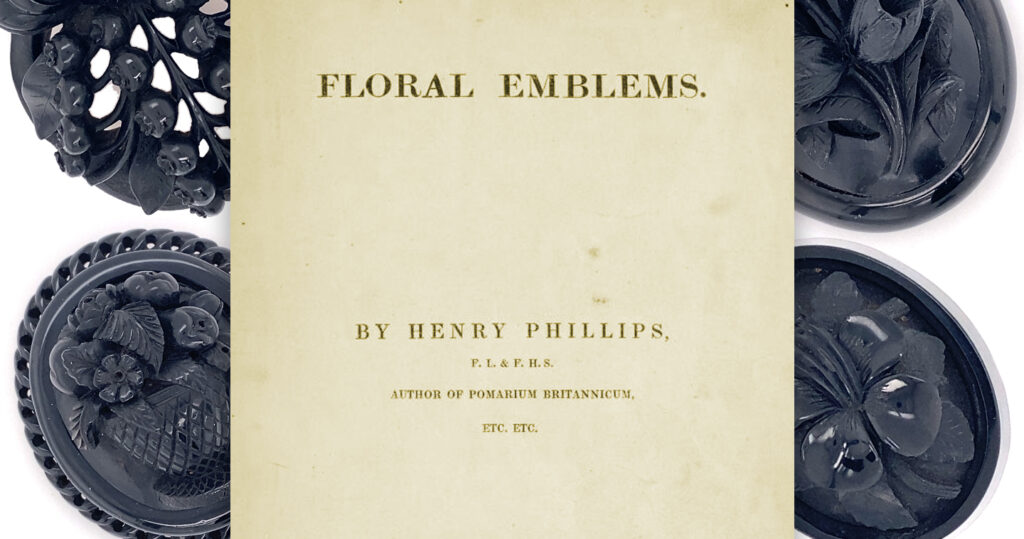
BEAUTY.
FULL-BLOWN Rose.—Rosa.
“Emblem of beauty! for to thee it is
That passion likens woman’s loveliness.”
Fitzjohn.
“ Rose ! thou art the sweetest flower
That ever drank the amber shower ;
Even the gods, who walk the sky,
Are amours of thy scented sigh.”
Moore’s Anacreon.
This queen of flowers is considered the pride of Flora, and the emblem of beauty in every part of the globe.
Locke says, Beauty consists of a certain composition of colour and figure, causing delight in the beholder.” And trouble in the breast say the Damons of every age.
Your beauty was the cause of that effect,
Your beauty, that did haunt me in my sleep.”
The rose is also symbolical of England ,but for which we would select the variegated or car nation rose, commonly called the York and Lancaster rose .
“Emblem of England, hail! thou fairest flower,
That paints the garden and perfumes the gale.”
Fitzjohn.
Floral Emblems Henry Philips, p.74-76
The second rule is, that if a flower presented a upright expresses a particular sentiment, when reversed it has a contrary meaning. Thus, for example, a rose bud upright with its thorns and its leaves means, “ I fear, but I hope;” if the same bud is returned held downwards, it signifies, you must neither hope nor fear ;” but if the thorns be stripped off, it expresses, there is everything to hope;” “there is deprived of its leaves, it signifies, everything to fear.” Thus the expression may be varied of almost all the flowers by changing their position. The flower of the marigold, for example, placed on the head, signifies “trouble of spirits;” on the heart, trouble of love;”on the bosom,” weariness.
Floral Emblems Henry Philips, p.25
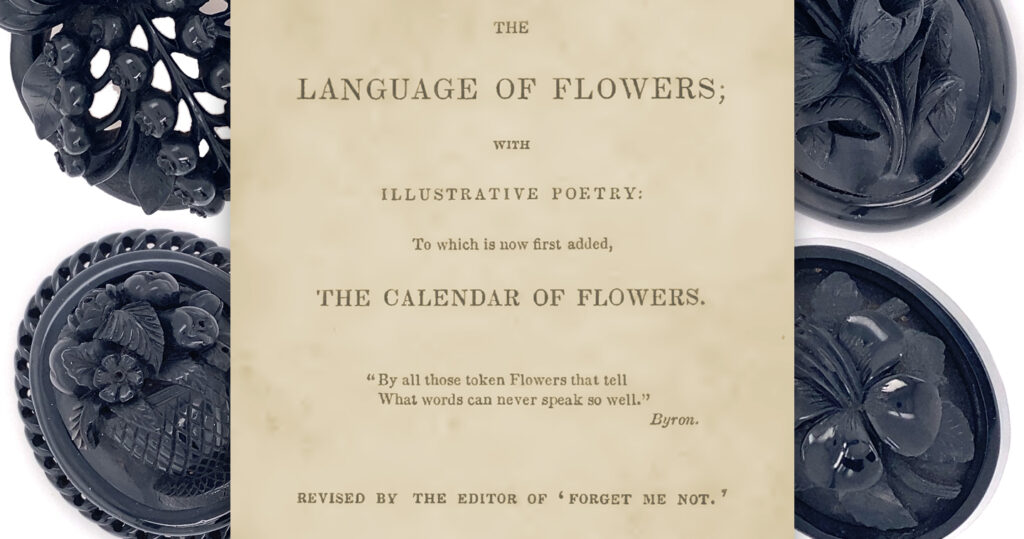
In the ages of chivalry, red was highly esteemed as the colour of love, and, accordingly,
the rose was, on account of its tint, a favourite emblem. Thus, in the romance of Perceforet, a hat adorned with roses is celebrated as a favourite gift of love ; and, in Amadis de Gaul, the captive Oriana is represented as throwing to her lover a rose wet with tears, as the sweetest pledge of her unalterable faith. The various allegorical meanings which were in the Middle Ages attached to the rose and described in the celebrated Romaunt de la Rose, which was commenced, in the year 1620, by Guillaume de Lorris, and finished, forty years later, by Jean de Meum.
In the famous German Heldenbuch, or Book of Heroes, which is supposed to have been chiefly written by Henry von Oferdingen, the Rose Garden of Wurms holds a distinguished place. This garden was encircled by a silken thread instead of a wall ; and the victorious knights who defended it against the encroachments of a party of giants were, by Princess Chrymhilde, rewarded with a chaplet of roses and a kiss. One of the knights, named Hildebrandt, is described as having accepted the chaplet but declined the salute. A monk, named Ilsan, however, who was one of the triumphant warriors, not satisfied with the rewards conferred on himself, remanded a chaplet and a kiss for each of the fifty-two monks of the convent to which he belonged. It is added that Chrymhilde granted this boon ; though not until Ilsan had fought and conquered fifty-two of the offending giants.
It was the etiquette of early times for a knight, on entering the lists at a tournament, to beg permission to wear the colours of the lady to whose service he was devoted ; but this practice was gradually succeeded by that of wearing about the person any pledge of love which the knight solicited from his mistress… This custom of giving and wearing favours was kept up until the middle of the seventeenth century.
In France, during the Middle Ages, flowers were much employed as emblems of love and friendship.
The Language of Flowers, p.118 – 126
ROSE.
LOVE.
WHO that ever could sing has not sung the Rose! The poets have not exaggerated its beauty, or completed its panegyric. They have called it daughter of heaven, ornament of the earth, glory of spring : but what expressions could ever do justice to them of this beautiful flower! Look at its grace fully rising from its elegant foliage, surrounded by its numerous buds : you would say that this queen of flowers sports with the air which fans her, that she decorates herself with the dewdrops which impearl her, that she smilingly meets the sunny rays which expand her bosom. Nature seems to have exhausted all her skill in the freshness, the beauty of form, the fragrance, the delicate colour, and the gracefulness which she has bestowed upon the Rose.
And then, it embellishes the whole earth; it is the commonest of flowers. The emblem of all ages, the interpreter of all our feelings, the Rose mingles with our festivities, our joys, and our griefs. Modesty borrows its delicate blush ; it is given as the prize of virtue; it is the image of youth, innocence, and pleasure; it is consecrated to Venus, the goddess of beauty, and, like her, possesses a grace more exquisite than beauty itself.
Anacreon, the poet of love, has celebrated the Rose in an ode, thus rendered by our English Anacreon :
While we invoke the wreathed spring,
Resplendent Rose ! to thee we’ll sing,
Resplendent Rose ! the flower of flowers,
Whose breath perfumes Olympus’ bowers ;
Whose virgin blush, of chasten’d dye,
Enchants so much our mortal eye,
Oft has the poet’s magic tongue
The Rose’s fair luxuriance sung;
And long the Muses, heavenly maids,
Have rear’d it in their tuneful shades.
When, at the early glance of morn,
It sleeps upon the glittering thorn,
‘Tis sweet to dare the tangled fence,
To cull the timid flow’ret thence,
And wipe, with tender hand, away
The tear that on its blushes lay!
‘Tis sweet to hold the infant stems,
Yet dropping with Aurora’s gems,
And fresh inhale the spicy sighs
That from the weeping buds arise.
When revel reigns, when mirth is high,
And Bacchus beams in every eye,
Our rosy fillets scent exhale,
And fill with balm the fainting gale!
Oh ,there is nought in nature bright,
Where Roses do not shed their light!
Where morning paints the orient skies,
Her fingers burn with roseate dyes!
And when, at length, with pale decline,
Its florid beauties fade and pine,
Sweet as in youth its balmy breath
Diffuses odour e’en in death!
O, whence could such a plant have sprung?
Attend- for thus the tale is sung ;
When humid from the silvery stream,
Effusing beauty’s warmest beam,
Venus appeared in flushing hues,
Mellowed by Ocean’s briny dews ;
When, in the starry courts above,
The pregnant brain of mighty Jove
Disclosed the nymph of azure glance!
The nymph who shakes the martial lance!
Then, then, in strange eventful hour,
The earth produced an infant flower,
Which sprung with blushing tinctures dress’d,
And wanton’d o’er its parent breast.
The gods beheld this brilliant birth, A
nd hailed the Rose, the boon of earth
With nectar drops, a ruby tide,
The sweetly orient buds they dyed,
And bade them bloom, the flowers divine
Of him who sheds the teeming vine;
And bade them on the spangled thorn
Expand their bosoms to the morn .
According to ancient Fable, the red colour of the Rose may be traced to Venus, whose delicate foot, when she was hastening to the relief of her beloved Adonis, was pierced by a thorn, that drew blood.
Which on the White Rose being shed,
Made it forever after red.
HERRICK
Its beautiful tint, is traced to another source by a modern poet:
As erst, in Eden’s blissful bowers,
Young Eve survey’d her countless flowers,
An opening Rose of purest white
She marked with eye that beam’d delight,
Its leaves she kiss’d, and straight it drew
From beauty’s lip the vermeil hue.
CAREY.
The origin of that exquisitely beautiful variety, the Moss Rose, is thus fancifully accounted for:
The Angel of the Flowers, one day,
Beneath a Rose Tree sleeping lay,
That Spirit to whose charge is given
To bathe young buds in dews from heaven.
Awaking from his high repose,
The Angel whispered to the Rose :
“O fondest object of my care,
Still fairest found where all are fair,
For the sweet shade thou’st given to me,
Ask what thou wilt,’tis granted thee.”
Then said the Rose with deepening glow,
“On me another grace bestow.”
The Spirit paused in silent thought
What grace was there that flower had not!
“Twas but a moment – o’er the Rose.”
A veil of moss the Angel throws;
And robed in Nature’s simplest weed,
Could there a flower that Rose exceed!
Pfeffel, a German poet, has pleasingly accounted for the Origin of the Yellow Rose, the emblem of envy, in the following manner:
Once a White Rose bud reared her head,
And peevishly to Flora said
“Look at my sister’s blushing hue
Pray, mother, let me have it too.”.
“Nay child,” was Flora’s mild reply,
“Be thankful for such gifts as I
Have deem’d befitting to dispense
They dower the huge of innocence.”
When did Persuasion’s voice impart
Content and peace to female heart Where baleful
Jealousy bears sway, And scares each gentler guest away!
The Rose still grumbled and complained,
Her mother’s bounties still disdained.
Well, then,” said angered Flora—“ take”
She breathed upon her as she spake
“Henceforth no more in simple vest
Of innocence shalt thou be drest-
Take that which better suits thy mind
The hue for Jealousy designed!”
The Yellow Rose has from that hour
Borne evidence of Envy’s power.
There is another strongly marked variety of this flower in the Thornless Rose. The author of that affecting tale,”The Leper of Aoste,” asserts that the thorns of the Rose are produced by cultivation;
and this theory naturally suggested the emblem of ingratitude which has been adopted. In both these assumptions, however, there appears to be a wide departure from the ideas usually attached to
a Rose without a thorn, which would more naturally present the image of love without alloy.
In the ” Legend of the Rose,” we find this account of the origin of the armour by which this flower is defended :
Young Love, rambling through the wood, Found me in my solitude,
Bright with dew and freshly blown,
And trembling to the Zephyr’s sighs;
But as he stooped to gaze upon
The living gem with raptured eyes,
It chanced a bee was busy there,
Searching for its fragrant fare;
And, Cupid, stooping too, to sip,
The angry insect stung his lip;
And gushing from the ambrosial cell,
One bright drop on my bosom fell.
Weeping, to his mother he
Told the tale of treachery,
And she her vengeful boy to please,
Strung his bow with captive bees,
But placed upon my slender stem
The poisoned sting she plucked from them :
And none since that eventful morn
Have found the flower without a thorn.
By the ancients the Rose was regarded as the emblem of joy. Accordingly, Comus, the god of feasting, was represented as a handsome young man, crowned with a garland of Roses, whose leaves glistened with dew-drops. As it was well known, even in those early times, that when the heart is full the mouth will run over, especially during the intoxication of mirth or of pleasure, the ancients feigned that sportive Cupid presented a Rose to Harpocrates, the grave god of silence, and thus made this flower a symbol of secrecy and silence. As such, a Rose was fastened up over the table at entertainments, that the sight of the flower might remind the guests that the mirthful sallies in which any of them might indulge were not to be proclaimed in the market-place. This custom gave rise to the saying “under the rose,”which was equivalent to an injunction of secrecy.
The Rose became celebrated in English history, from its having been adopted in the fifteenth century as the badge of the rival houses of York and Lancaster, the white being chosen by the former, the red by the latter. Shakespeare, in his Henry the Sixth, represents this feud as having originated in the Temple Garden. The Earls of Somerset, Suffolk, and Warwick, Richard Plantagenet, nephew and heir of Edmund Mortimer, with Vernon, and another lawyer, are the characters introduced. Suffolk says:
Within the Temple Hall we were too loud:
The garden here is more convenient.
Plantag . Since you are tongue-tied, and so loth to speak,
In dumb significance proclaim your thoughts:
Let him that is a true-born gentleman,
And stands upon the honour of his birth,
If he supposes I have pleaded truth,
From off this briar pluck a White Rose with me.
Somers. Let him that is no coward, nor no flatterer,
But dare maintain the party of the truth,
Pluck a Red Rose from off this thorn with me.
This example is followed by their respective friends, and after a threatening altercation, Warwick, addressing Plantagenet, says:
In signal of my love to thee,
Will I upon thy party wear this Rose :
And here I prophecy, this brawl to-day,
Grown to this faction in the Temple Garden,
Shall send, between the Red Rose and the White,
A thousand souls to death and deadly night.
What torrents of blood were shed in the civil wars, called the Wars of the Roses, which succeeded, history has duly recorded. The subsequent blending of the interests of the two houses, and their union by the marriage of HenryVII. With the heiress of the York family, are prettily typified in the colouring of the York and Lancaster Rose.
In the East, the Rose is an object of peculiar esteem, and the acceptance of this flower when offered is a token of the highest favour. However interesting it might be to collect the various oriental legends and traditions in which the Rose acts a principal part, I must abstain from the attempt, otherwise this single article might be swelled to the size of a decent volume, especially if I should include the many charming illustrations of the love of the nightingale for the Rose. In a fragment by the celebrated Persian poet Attar, entitled Bulbul Nameh- The Book of the Nightingale- all the birds appear before Solomon, and charge the nightingale with disturbing their rest by the broken and plaintive strains which he warbles forth in a sort of frenzy and intoxication. The nightingale is summoned, questioned, and acquitted by the wise king, because the bird assures him that his vehement love for the Rose drives him to distraction, and causes him to break forth into those languishing and touching complaints, which are laid to his charge. Thus the Persians believe that the nightingale in spring flutters around the Rose-bushes, uttering incessant complaints, till, overpowered by the
strong scent, he drops stupified on the ground. Among the ancients it was customary to crown new-married persons with a chaplet of Red and White Roses; and, in the processions of the Cory
bantes, the goddess Cybele, the protectress of cities, was pelted with White Roses. The pelting with Roses is still common in Persia, being practised during the whole time that these flowers are in blossom. A company of young men repair to the places of public entertainment to amuse the guests with music, singing, and dancing ; and, in their way through the streets, they pelt the passengers whom they meet with Roses, and receive a little gratuity in return.
In the middle ages, the queen of flowers contributed to a singular popular festival at Treviso, in Italy. In the middle of the city, the inhabitants erected a castle, the walls of which were formed of
curtains, carpets, and silk hangings. The most distinguished unmarried females of the place defended this fortress, which was attacked by the youth of the other sex. The missiles with which both parties fought consisted of apples, almonds, nutmegs, lilies, narcissuses, violets, but chiefly of Roses, which supplied the place of artillery. Instead of musketry, they discharged volleys of Rose water and other liquid perfumes, by means of syringes. This entertainment attracted thousands of spectators from far and near, and the emperor Frederick Barbarossa himself accounted it one of the highest diversions that he had ever enjoyed.
In like manner, St. Medard, bishop of Noyon, in France, instituted in the sixth century a festival at Salency, his birth-place, for adjudging one of the most interesting prizes that piety has ever offered to virtue. This prize, consists of a simple crown of Roses, bestowed on the girl who is acknowledged by all her competitors to be the most amiable, modest, and dutiful. The founder of this festival enjoyed the high gratification of crowning his own sister as the first Rose-queen of Salency. The lapse of ages, which has overturned so many thrones and broken so many sceptres, has spared this simple institution ; and the crown of Rose still continues to be awarded to the most virtuous of the maidens of that obscure village.
The Language of Flowers, p.118 – 126

Rose… Love.
Rose, Austrian… Thou art all that is lovely.
Rose, Bridal… Happy love.
Rose, Burgundy… Unconscious beauty.
Rose, Cabbage… Ambassador of love.
Rose, Campion… Only deserve my love.
Rose, Carolina… Love is dangerous.
Rose, China… Beauty always new.
Rose, Christmas… Tranquilize my anxiety
Rose, daily… They smile I aspire to.
Rose, Damask… Brilliant complexion.
Rose, Deep Red… Bashful shame.
Rose, Dog… Pleasure and pain.
Rose, Guelder… Winter. Age.
Rose, Hundred leaved… Pride.
Rose, Japan… Beauty is your only attraction.
Rose, Mainden Blush… If you love me, you will find it out.
Rose, Multiflora… Grace.
Rose, Mundi… Variety.
Rose, Musk… Capricious beauty.
Rose, Musk, Cluster… Charming.
Rose, Single… Simplicity.
Rose, Thornless.. Early attachment.
Rose, Unique… Call me not beautiful.
Rose, White… I am worthy of you.
Rose, With (withered)… Transient impressions.
Rose, Yellow… Decrease of love. Jealousy.
Rose, York and Lancaster… War.
Rose, Full-blown, placed over two Buds… Secrecy.
Rose, White and Red together… Unity.
Roses, Crown of… Reward of virtue.
Rosebud, Red… Pure and lovely.
Rosebud, White… Girlhood.
Rosebud, Moss… Confession of love.
The Illustrated Language of Flowers, p.52-53




